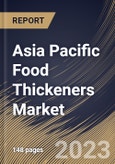One of the primary functions of food thickeners is to enhance the texture of food products. They contribute to creaminess, viscosity, and mouthfeel, ensuring a satisfying eating or drinking experience. Thickeners are crucial in stabilizing emulsions and preventing phase separation in products such as sauces, dressings, and beverages. This not only enhances product appearance but also extends shelf life. Using thickeners as fat alternatives and the demand for healthier dietary options are growing. They can mimic the creamy texture of fats, allowing for the development of low-fat or fat-free alternatives. Some food thickeners have gelling properties, making them ideal for creating gels and jellies. This is particularly relevant in producing jams, desserts, and certain confectionery items.
Clean-label products are in greater demand as consumers become more discerning about the ingredients in their food. This has led to development natural and plant-based thickeners as alternatives to traditional synthetic options. Plant-based diets have spurred innovation in developing thickeners derived from plant sources such as seaweed, guar gum, and pectin. These plant-based options cater to the preferences of environmentally conscious consumers. Food science and technology advances have led to the development of novel thickeners with improved functionalities.
As per the U.S. Department of Agriculture, the total value of retail food and beverage (F&B) sales in Japan increased by 1.5 percent to $474.13 billion in 2020, compared to $466.97 billion in 2019. Providing information on labels in multiple languages can cater to diverse consumer demographics in China. With increasing consumer awareness and health consciousness in China, consumers are paying more attention to product labels. As per the International Trade Administration, according to the Food Labelling Standards of China (GB7718-2011), imported foods must be marked with the nation of origin and the name and address of the general distributor registered in the country, among other details. Due to these aspects, the food thickeners market will expand across the Asia Pacific region in upcoming years.
The China market dominated the Asia Pacific Food Thickeners Market, by Country in 2022, and would continue to be a dominant market till 2030; thereby, achieving a market value of $1,582.5 million by 2030. The Japan market is registering a CAGR of 5.6% during (2023 - 2030). Additionally, The India market would showcase a CAGR of 7% during (2023 - 2030).
Based on Type, the market is segmented into Starch, Hydrocolloids, and Protein. Based on Application, the market is segmented into Dairy & Frozen Desserts, Bakery, Convenience & Processed Food, Beverages, Sauces, Dressings, Marinades, & Gravies, and Confectionery. Based on Source, the market is segmented into Plant, Animal, and Microbe. Based on countries, the market is segmented into China, Japan, India, South Korea, Singapore, Malaysia, and Rest of Asia Pacific.
The market research report covers the analysis of key stake holders of the market. Key companies profiled in the report include Cargill, Incorporated, Archer Daniels Midland Company, DuPont de Nemours, Inc., Kerry Group, Plc., Tate & Lyle Plc., Fuerst Day Lawson Ltd., Ingredion Incorporated, Darling Ingredients Inc., Ashland Inc. and CP Kelco U.S., Inc.
Scope of the Study
Market Segments Covered in the Report:
By Type (Volume, Kilo Tonnes, USD Billion, 2019-2030)- Starch
- Hydrocolloids
- Protein
- Dairy & Frozen Desserts
- Bakery
- Convenience & Processed Food
- Beverages
- Sauces, Dressings, Marinades, & Gravies
- Confectionery
- Plant
- Animal
- Microbe
- China
- Japan
- India
- South Korea
- Singapore
- Malaysia
- Rest of Asia Pacific
Key Market Players
List of Companies Profiled in the Report:
- Cargill, Incorporated
- Archer Daniels Midland Company
- DuPont de Nemours, Inc.
- Kerry Group, Plc.
- Tate & Lyle Plc.
- Fuerst Day Lawson Ltd.
- Ingredion Incorporated
- Darling Ingredients Inc.
- Ashland Inc.
- CP Kelco U.S., Inc.
Unique Offerings
- Exhaustive coverage
- The highest number of Market tables and figures
- Subscription-based model available
- Guaranteed best price
- Assured post sales research support with 10% customization free
Table of Contents
Companies Mentioned
- Cargill, Incorporated
- Archer Daniels Midland Company
- DuPont de Nemours, Inc.
- Kerry Group, Plc.
- Tate & Lyle Plc.
- Fuerst Day Lawson Ltd.
- Ingredion Incorporated
- Darling Ingredients Inc.
- Ashland Inc.
- CP Kelco U.S., Inc.
Methodology

LOADING...








